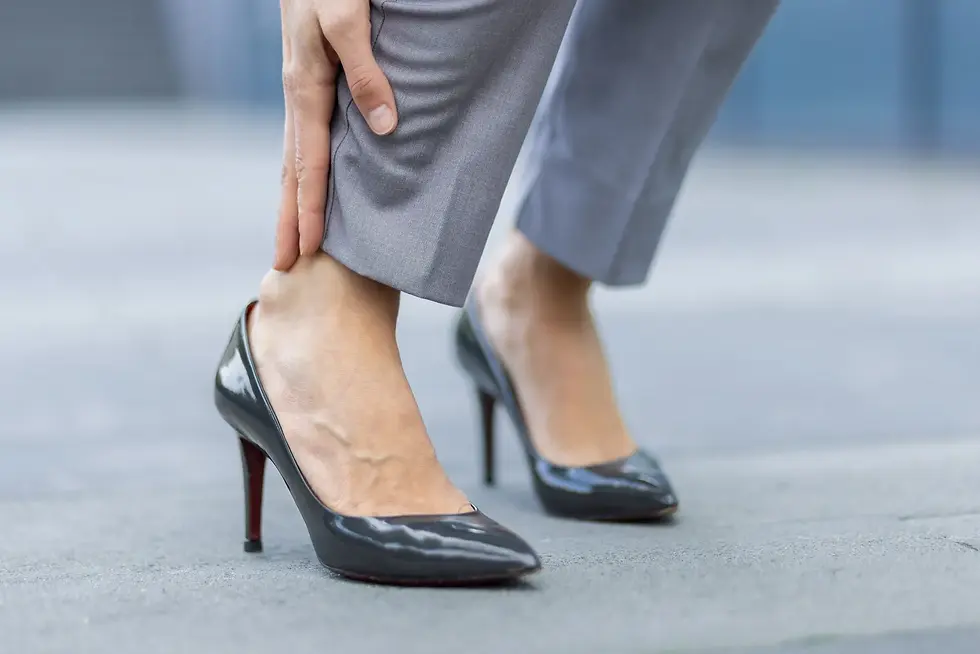Shin Splints: An In-Depth Guide to Understanding and Treating Medial Tibial Stress Syndrome
- My Family Podiatry

- Mar 17, 2021
- 4 min read
Updated: Dec 15
Shin splints, clinically known as medial tibial stress syndrome (MTSS), are a common condition affecting athletes across a number of different sports and of all ages and skill levels. At My Family Podiatry, we frequently see patients struggling with shin splints after increasing or resuming physical activity. But what exactly are shin splints, and how can you find relief?
Understanding Shin Splints
Shin splints involve irritation of the tibia (shin) bone's periosteum and the muscles connected to it. Pain is typically felt along the shin bone's inner edge and worsens after exercising. One characteristic that sets shin splints apart from more severe injuries is that the pain often "warms up," meaning it decreases during exercise but returns once the activity is over.
Shin splints result from increased stress on the lower leg that the body isn't ready to handle. This could stem from a sudden change in training load (more frequent, longer, or intense workouts) or alterations in how stress is applied to your feet and legs (different shoes or training surfaces). Consequently, shin splints often affect people who return to running after a break or individuals participating in sports they haven't practiced since the previous season. Two other groups that commonly report shin splints are dancers and military recruits due to the extreme demands placed on their legs and feet.

Risk Factors for Developing Shin Splints:
Flat (pronated) foot type: This foot position can increase the strain on muscles, leading to increased irritation at their attachment points on the bone.
High, rigid arch foot type: This foot position typically has poor shock absorption, potentially increasing stress on the lower leg.
Inadequate footwear: Shoes with insufficient cushioning and support may raise the likelihood of shin splints.
Abrupt return to exercise: Without properly conditioning your body for the stresses you're placing on it, bones and muscles can become irritated and damaged, leading to shin splints.
Symptoms of Shin Splints
Pain along the tibia (shin bone): This pain can present in a number of ways including a sharp, razor-like slicing sensation through to a dull consistent ache. This pain is often most severe in the early stages of a work out, improving as the tissue warms up before returning when exercise concludes.
Mild swelling along the shin bone: A natural inflammatory response, the body can swell as it attempts to heal and protect the damaged area.
Tenderness along the shinbone: The shin bone can become tender to the touch, with even light pressure inducing pain. This pain is normally spread over an area of the shinbone, not focused on one specific spot.
Shin Splints Treatment
Rest: As an overuse injury, taking a break from the aggravating activity for 3-4 weeks can help reduce pain. Consider lower-intensity exercises like swimming, cycling, or using an elliptical machine.
Proper Footwear: Suitable shoes can help manage the forces applied to your feet and lower legs. Stability trainers are recommended for flat feet, while cushioned, neutral trainers are ideal for high and rigid feet.
Orthotics: Custom foot orthotics can be crafted by My Family Podiatry to ensure proper force distribution and place your foot in a more neutral position, reducing lower limb stress and speeding up your return to activity.
Shockwave Therapy: For persistent or recurring shin splints that are slow to respond to rest and load modification, shockwave therapy may be recommended. Shockwave works by stimulating blood flow, promoting tissue repair, and reducing pain sensitivity in chronically overloaded tissues. It is commonly used when symptoms have been present for several months or continue to return with training.
Training Load Management: Gradually progressing in exercise is crucial for conditioning your body. Consider adding just one extra day of jogging to your routine rather than jumping from one to five days of exercise all at once. Monitor your total weekly training volume to ensure gradual increases.
How a Sports Podiatrist Can Help
Many athletes, especially runners, suffer from pain on the inside of the shinbone caused by overuse or repetitive strain.
Anyone struggling with shin pain should definitely see a sports podiatrist, especially if the pain persists or worsens despite all efforts at self-treatment.
A sports podiatrist offers a multi-faceted approach to treating shin splints that includes an accurate diagnosis, personalised treatment plans with rest and specific exercises, footwear advice tailored to individual needs, custom orthotics to address biomechanical issues and proactive strategies for prevention.
While self-help measures such as rest and ice can be helpful in treating shin splints, professional intervention is often required for persistent or severe cases.
Consulting a sports podiatrist ensures a comprehensive assessment and targeted treatment that facilitates effective treatment and recovery for individuals with shin splints.
When It Might Be More Than Shin Splints
Some lower leg issues are more severe than shin splints. Contact My Family Podiatry for a thorough investigation if you experience any of the following:
Pain that worsens with exercise and doesn't warm up.
Pain after exercise that's severe enough to wake you up at night.
Pain at a very specific point on the shin bone, causing significant discomfort.
If you or someone you know is struggling with shin splints, don't let this injury hold them back from exercise and activities. Call My Family Podiatry at 07 3088 6116 or use the button below to book an appointment and let us treat your shin splints.




Comments